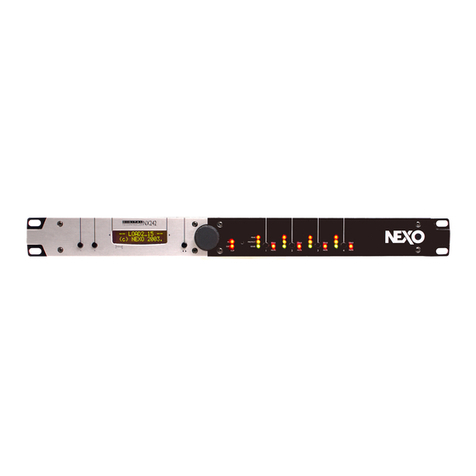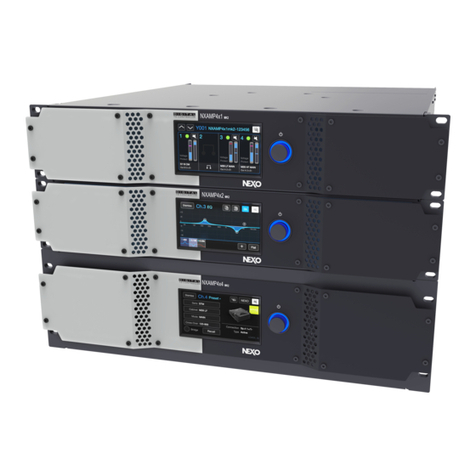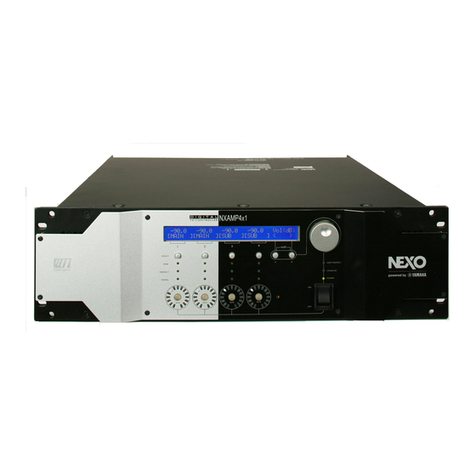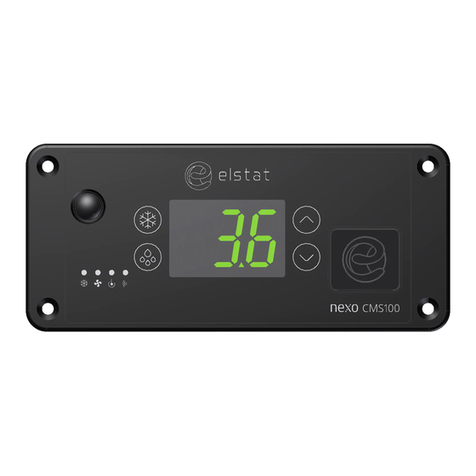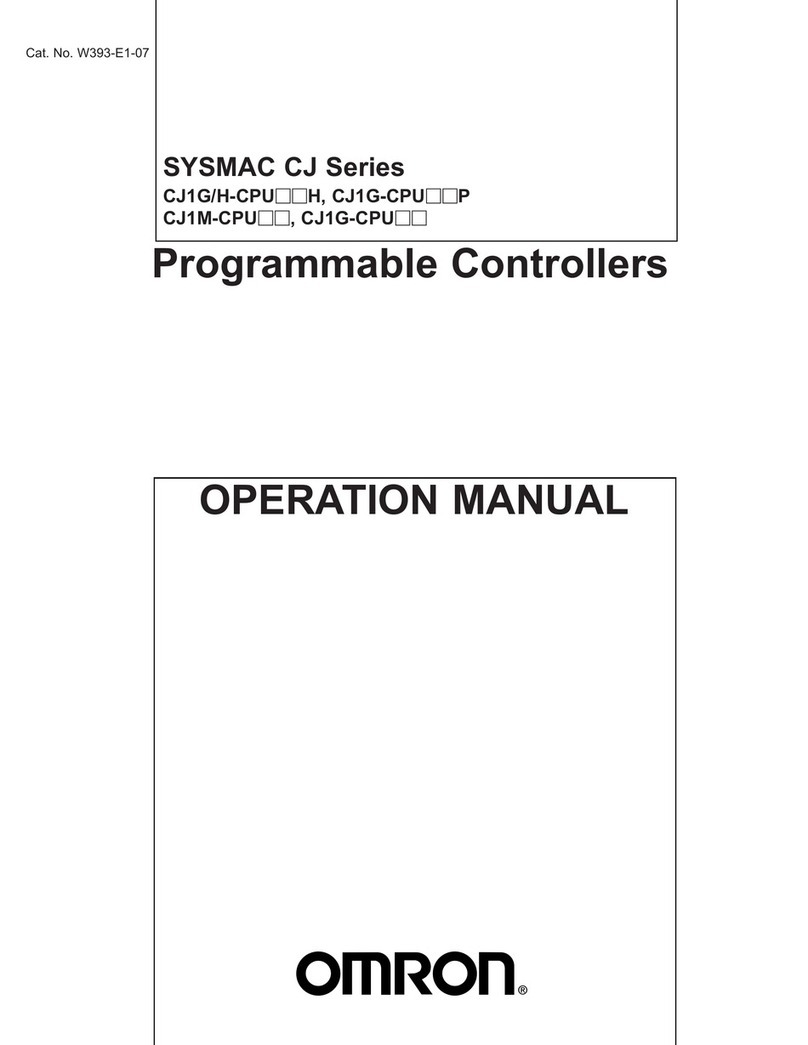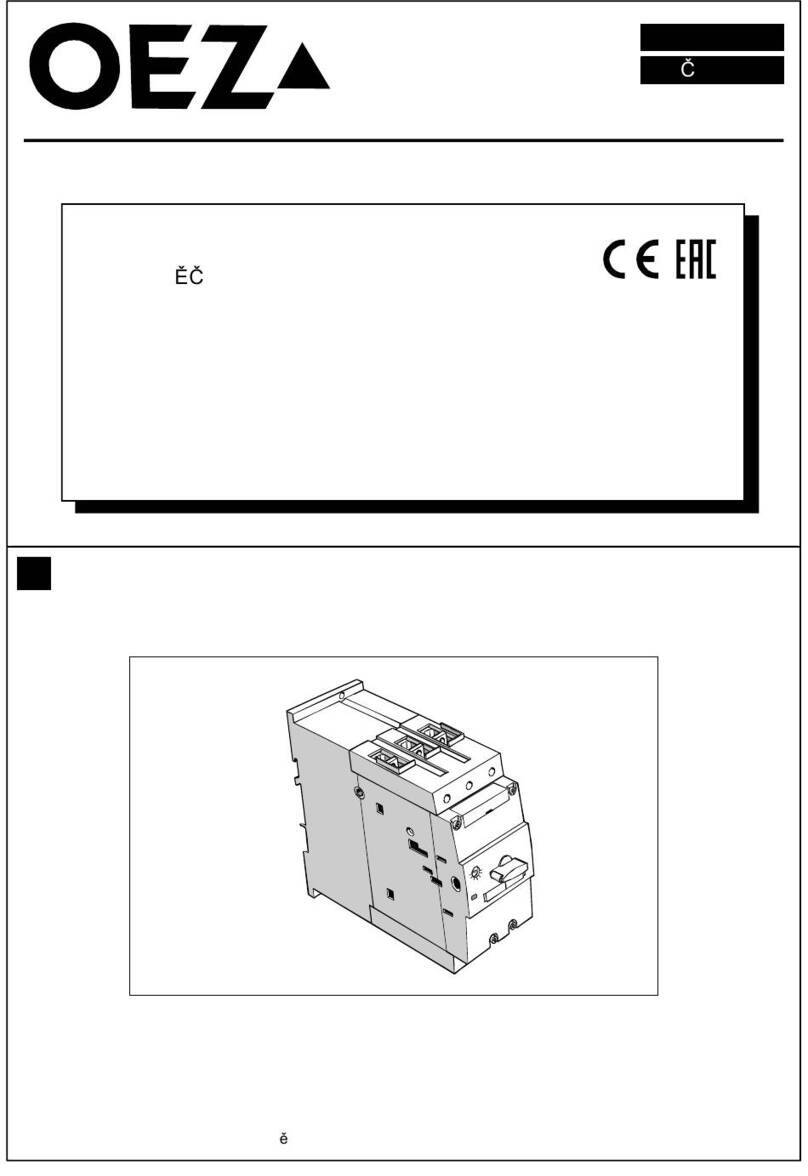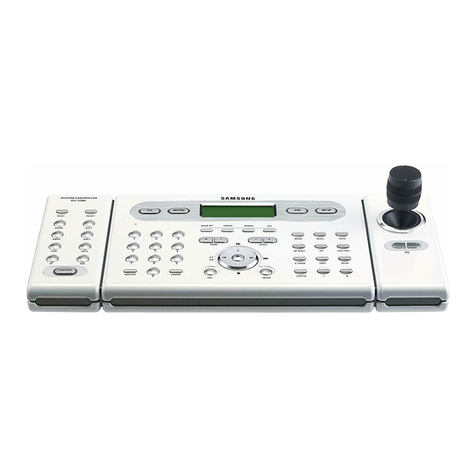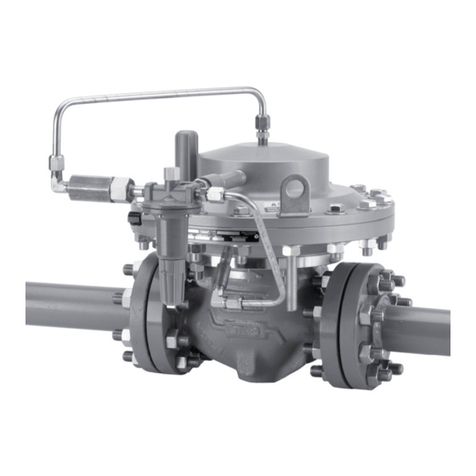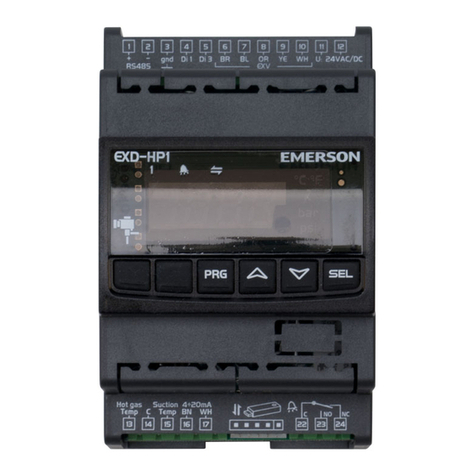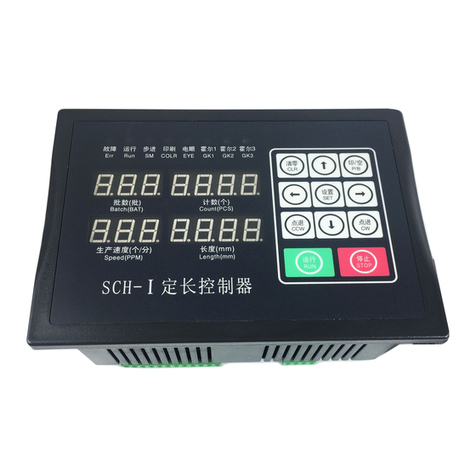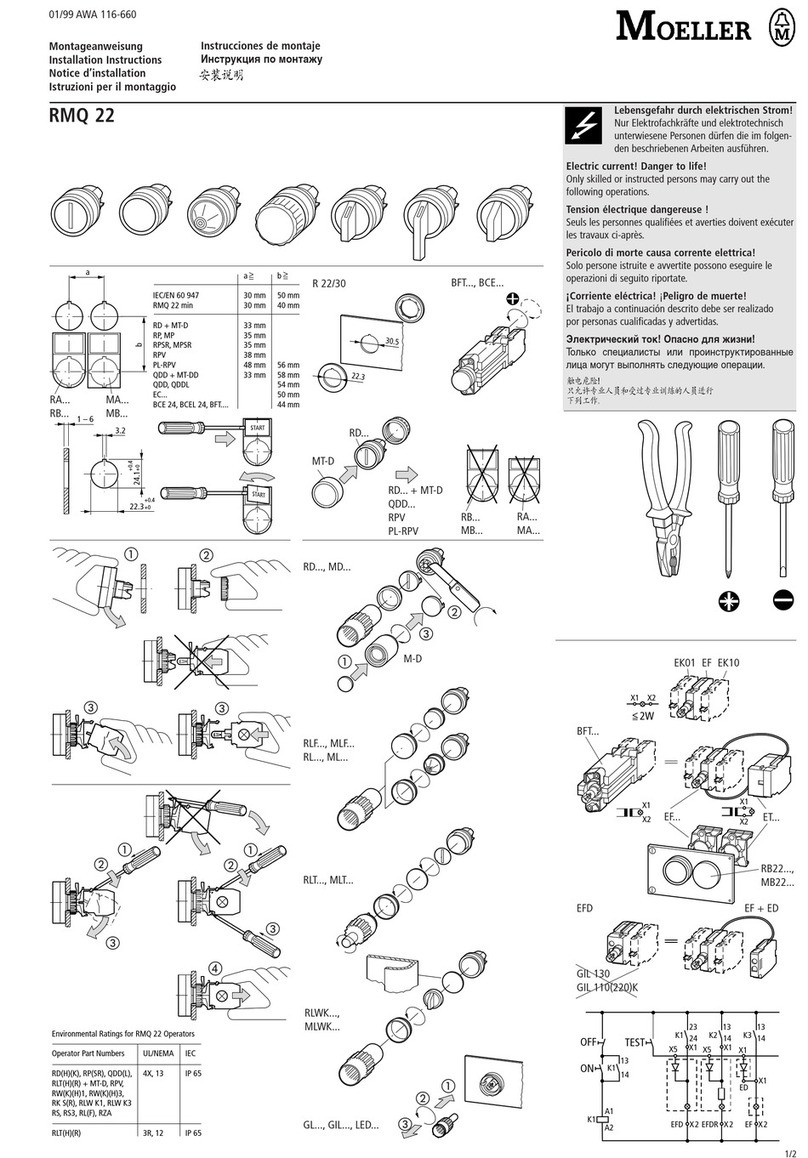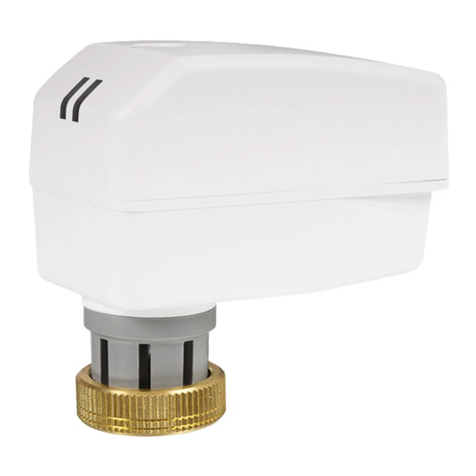Nexo CMS100 User manual

CMS100
PRODUCT MANUAL Issue 8

Copyright © Elstat Ltd
2017 All Rights Reserved
All information in this document is property of
Elstat Ltd
Commercial use and distribution of the contents
of this publication is not allowed without express
and prior written consent of Elstat Ltd

CMS100 Product Manual, Issue 8
www.nexo.com Page 3
CONTENTS
1. CONTROLLER WITH INTELLIGENCE
1.1 Functionality 5
1.2 User interface 6
1.3 Overall dimensions 7
1.4 Mounting 8
1.5 Electrical connections 9
1.6 Programming port cover 9
1.7 Wiring diagram 10
1.8 Relay ratings 11
1.9 Temperature input ranges 11
1.10 Environmental ratings 12
2. ACCESSORIES
2.1 Temperature sensors 13
2.2 Door switch 15
2.3 Motion sensor 17
2.4 Transformer 18
3. USER GUIDE
3.1 Power-up sequence 19
3.2 Function buttons 19
3.3 (GDC) Firmware menus 20
3.4 The menu arrangement 21
3.5 Menu access 22
3.6 Test routines (tSt) 22
3.7 Viewing the last three cooler faults witnessed by the controller (FLt) 30
3.8 Half reset (Hr) 31
3.9 Viewing statistics 33
4. CONTROLLER ALARM OPERATIONS
4.1 ‘Limp home’ functionality 35
4.2 Door open alarms 35
4.3 Door alarms ‘Limp home’ mode 36

CONTENTS
Product Manual, Issue 8 CMS100
www.nexo.comPage 4
4.4 Temperature sensor alarms 37
4.5 Appliance sensor alarms 37
4.6 Refrigeration system failure (rSF) alarms 38
5. COOLER AND CONTROLLER TROUBLESHOOTING TIPS
5.1 RSF Alarms 39
5.2 Door Switch Broken Alarms 39
5.3 Door Broken Alarms 39
5.4 Appliance Sensor Alarms 39
5.5 Condenser Sensor Alarms 40
5.6 Freeze-up protection (888) 40
5.7 Condenser high temperature (Ht) alarms 40
5.8 Other Problems 41
6. PARAMETERS
6.1 Parameters by function 43
6.2 Parameter validation 44
6.3 Parameters denition 44
7. APPROVALS
7.1 Product Approvals 57
7.2 Bluetooth Approvals 58
8. GLOSSARY OF TERMS
8.1 Acronyms 59
8.2 Controller and accessory terms 59

CMS100 Product Manual, Issue 8
www.nexo.com Page 5
1. CONTROLLER WITH INTELLIGENCE
The Nexo controllers are the rst truly
intelligent refrigeration solution for
the beverage industry that delivers
consumer insights from eld data to
optimize and take complete control of
cold drink marketing.
Elstat’s game-changing Nexo platform
is a powerful tool that connects drink
brands directly to consumers at the
point of sale, wherever they are in
the world, to create sustainable and
protable relationships.
The energy management system (ems) controllers from Elstat are used in a variety of drinks coolers,
optimising energy savings, without compromising on drinks serving temperature.
The CMS100 Nexo controller is designed for applications such as single door coolers, double door coolers
and vending machines.
1.1 Functionality
Feature Description
User and
diagnostic
information
3-digit, 7-segment display that displays the product temperature and other information
such as defrost or teach and alarm conditions. Also push buttons, that enable the end-
users to cancel alarms and service technicians to run test routines.
Product
temperature
An appliance sensor measures temperature of the refrigeration compartment. EMS
controllers use the refrigeration temperature to manage the product temperature.
Refrigeration
system high
temperature alarm
An optional condenser sensor measures the temperature of the refrigeration system.
EMS controllers use the temperature to alert to problems such as blocked condensers.
Motion detection A remote or integrated motion sensor enables EMS controllers to detect activity when
someone moves in front of the cooler.
Door open
detection
A door switch enables EMS controllers to detect cooler activity when someone opens the
cooler doors.
The controllers switch the following cooler components:
Feature Description
Compressor EMS controllers switch the compressor to manage the temperature of the refrigeration
compartment.
Evaporator fan EMS controllers can control the evaporator fan.
Lights EMS controllers can control the cooler lights to save energy.

Product Manual, Issue 8 CMS100
www.nexo.comPage 6
1.2 User interface
All Elstat controllers are made from food grade materials and are safe for internal installation. The
CMS100 controllers are available with either an integrated or a remote motion sensor.
Controller with integrated motion detection
(IMD)
Controller with remote motion detection
(RMD)
10
911
1 2 3 4
57
8
6
This variant should always be installed where the
sensor can ‘see’ activity. It is recommended that the
controller is installed externally on the cooler.
This variant of the controller can be installed
internally on the cooler but the remote motion
sensor must be installed where it can ‘see’ activity.
Item LED Indicator Name Function Colour
1Compressor On when the compressor is running. Green
2Evaporator fan On when the evaporator fan is running. Green
3Saving temperature
disable
On if the saving temperature is disabled.
The controller maintains the Ready mode
temperatures at all times.
Red
4Motion On when motion sensor detects motion from
passing shoppers. Red
Item Push Button Name Function
5Set Accept/forward - selects menu options and parameters.
6Defrost
Return/backward - De-selects menu options and parameters.
Activates a manual defrost
(only applicable if temp is below termination temp).
7Up Scrolls up menus.
Increases parameter values.
8Down Scrolls down menus. Decreases parameter values. Cancels the
rSF, d0 and Ht alarms.

CMS100 Product Manual, Issue 8
www.nexo.com Page 7
Item On display Name Function
9Motion Sensor Detects motion
10 LED Display Displays the current status of the controller
11 Programmable Port Enables upload of parameters using a dongle
1.3 Overall dimensions
The overall dimensions of the controller are shown in the following diagram.
142 mm
127.8 mm
47.8 mm
63 mm
120 mm
41 mm
103 mm

Product Manual, Issue 8 CMS100
www.nexo.comPage 8
1.4 Mounting
CMS100 Nexo
controllers are
designed for panel
mounting and are
secured using four
countersunk self-
tapping screws.
The aperture
and screw pitch
dimensions are as
shown.
Note
The Water Ingress Protection ratings (IP ratings) are only valid when the product is
mounted in the recommended orientation shown below.
Failure to follow these guidelines will invalidate the designed levels of Ingress Protection
and any subsequent damage incurred will not be covered under the warranty terms.
In addition, incorrect installation may result in the following conditions:
`If mounted vertically with the integrated
motion sensor close to the oor, the motion
sensor may not be able to detect motion
eectively.
`If mounted vertically with [parameter
programming port] close to the oor, water
ingress may occur.
`If mounted too close the oor, water ingress
may occur at the mains or line voltage
terminals.
Cable routing to the CMS100 controller is critical as water can trace
or follow the cable downwards.
Therefore, immediately prior to the connection to the controller, a
drip loop must be formed in all wiring as shown.
An appropriate level of protection must be given for the eects of
water ingress due to condensation, product spillage, and so on.
Note
Cable routing looms must not be secured to hot pipes or vibrating components. Secure
cable routing looms with clips where ever possible.
Ensure that the back of the controller is protected from the possibility of unauthorized
tooled access with an appropriate strain relief on cables.
122.0 -0.2
0.2
+ mm
47.8 -0.2
0.2
+ mm
2.9 -0.2
0.2
+ mm
42.0 -0.2
0.2
+ mm
2.9 -0.2
0.2
+ mm
127.8 -0.2
0.2
+ mm
3.0
-0.2
0.2
+ mm

CMS100 Product Manual, Issue 8
www.nexo.com Page 9
1.5 Electrical connections
Item Description Connectors
1 Compressor
61 23 4 578 9 10 11
2 Line in
3 Fan(s)
4 Light(s)
5 Product Sensor
6 12VAC
7 Evaporator Sensor
8 Door
9 Condenser Sensor
10 Appliance Sensor
11 Remote Motion Detector
(If applicable)
1.6 Programming port cover
When accessing the programming port on
the controller fascia, remove the rubber
cover and let it hang on the attaching strap.
This will prevent misplacing the port cover.
Note
Do not remove programming port cover fully. Detaching the cover from the controller
fascia can damage the attaching strap.
On completion of controller
programming, ensure that the
programming port cover is replaced
inserting the left edge rst then
securing the other edges in place
moving in clockwise direction.

Product Manual, Issue 8 CMS100
www.nexo.comPage 10
1.7 Wiring diagram
Note
To remove the potential for damage occurring to, and the potential for failure of,
the crimped connection on the mating half of terminals 1 to 4 of the CMS100 Nexo
controller it is recommended that only right angle insulated 6.3mm tab connectors,
complete with strain relief, are used to terminate these cables. Use of straight
connectors may exert excessive pressure on to that connector.
A - Controller I - Modem interface R - Lights out
B - Appliance sensor J - Motion sensor S - Line in
C - RMD K - 12VAC T - Transformer
D - Evaporator sensor L - Live U - Evaporator fan
E - Door switch N - Neutral V - Lights
F - RJ45 Port M - Stock / product sensor W - Compressor
G - Condenser sensor P - Fan out
H - Display Q - Compressor out
Note
An additional input has been inserted between 12AV and Auxiliary inputs. The order
does vary to Elstat’s ems55adv models.

CMS100 Product Manual, Issue 8
www.nexo.com Page 11
1.8 Relay ratings
Relay Maximum IEC rating
@100-240VAC
Maximum UL ratings
@ 120VAC
Compressor 10 (10) A, p.f. 0.6 16 FLA, 96 LRA
Lights 4 (4) A, p.f. 0.6 250W ballast
Evaporator fan 4 (4) A, p.f. 0.6 4.4 FLA, 13.1 LRA
Note
This controller is designed for integration into 3rd party equipment only and should
be installed according to these instructions and all relevant local electrical and safety
standards.
1.9 Temperature input ranges
Sensor Input range (°C) Input range (°F)
Appliance sensor -15°C to 50°C +/- 0.5°C 5°F to 122°F +/- 1°F
Condenser sensor 50°C to 125°C +/- 5.0°C 122°F to 257°F +/- 10°F
Evaporator sensor -15°C to 50°C +/- 0.5°C 5°F to 122°F +/- 1°F
Note
The NTC (negative temperature coecient) thermistor from Elstat is rated at:
-35°C to 125°C (-31°F to 257°F).

Product Manual, Issue 8 CMS100
www.nexo.comPage 12
1.10 Environmental ratings
Characteristic Value
IP (Ingress Protection) Rating IP45 Front Fascia, IP24 All Over
Maximum operating temperature 55°C (131°F)
Minimum operating temperature 0ºC (32ºF)
Housing material Black polycarbonate, Food grade
(non-contact)
Operating control Electronic Thermostat
Construction Class II (SELV electronic control)
Software Class Class A
Limitation of operating control Continuous
Action Type 1B
Control pollution degree Degree 2
Rated impulse voltage Loads 2.5KV
Control 330V (SELV*)
Temperature ball pressure test
160ºC (PCB)
125ºC (Enclosure)
75ºC (front face)

CMS100 Product Manual, Issue 8
www.nexo.com Page 13
2. ACCESSORIES
2.1 Temperature sensors
Temperature sensors are available from Elstat with various cable lengths. To help identify sensor cables
during the installation, Elstat can supply sensor cables with blue identication sleeves. For example,
if the appliance sensor cable is plain black; the condenser sensor cable can be purchased with a blue
identication sleeve.
The sensor circuit is designed for safety extra low voltage (SELV). Therefore, if the sensor cable needs to be
joined during production or maintenance, only connectors normally used in SELV circuits can be used.
Note
Connectors designed to carry mains voltages must not be used to join cables to the
sensor circuit.
The temperature sensors have a negative temperature coecient (NTC). Each make and type of sensor has
a specic resistance versus temperature curve. Therefore, only sensors supplied by Elstat should be used.
The NTC thermistor is rated from -35ºC to 125ºC (-31ºF to 257ºF).
2.1.1 Appliance sensor
The appliance sensor measures air temperature
of the refrigerated compartment by measuring
the return air temperature.
The diagram shows the
recommended position of
the appliance sensor.
The appliance sensor
measures the air
temperature after the
air has been drawn over
the products. The return
air provides a close
approximation of the
product temperature.
To measure the return air
temperature, secure the sensor to allow air to ow over the sensor head.
The sensor head should be placed at a right-angle to the air ow and secured using a
P-clip. The sensor head should not be completely covered by the P-clip or the sensor
will not function correctly.
Note
The sensor head is fragile and can easily be damaged. Do not use cable ties to secure
the sensor head or sensor cable as this invalidates the warranty.
To help place the appliance sensor, the parameter calibration 1 (CA1) denes an oset temperature. For
more information refer to Parameters section.

Product Manual, Issue 8 CMS100
www.nexo.comPage 14
2.1.2 Condenser sensor
This sensor measures the temperature of the refrigeration system. Excessive condenser temperature is
usually due to poor preventive maintenance, such as poorly cleaned condenser, or condenser fan failure.
EMS controllers can generate alarms if the refrigeration system temperature rises too high.
Note
Condenser sensor needs to be mounted on the liquid pipe of the condenser.
The value of the high
temperature is set
by measuring the
refrigeration system
temperature, when
the condenser is
approximately 75%
blocked.
The temperature is then set as the value of the condenser high temperature
(Ht) parameter. Ensure that the condenser sensor is xed using a metal pipe
clip (1) or foil tape (2) as shown.
Elstat can supply pipe clips for 6-8 mm and 8-10 mm pipes.
A
B
C
D
E
A - Condenser hot gas pipe (Condenser inlet pipe)
B - Condenser
C - Compressor
D - Liquid pipe (Condenser outlet pipe)
E - HT Sensor (Dual temperature sensor)
Caution
Do not use cable ties. The head of the sensor is fragile and can be easily damaged. Using
cable ties to secure the sensor head or sensor cable invalidates the warranty.
Do not attach sensor cables to hot pipes or allow the sensor cables to come into contact
with hot pipes.

CMS100 Product Manual, Issue 8
www.nexo.com Page 15
2.1.3 Evaporator sensor
The evaporator sensor measures the temperature of the evaporator.
2.2 Door switch
Door switches are used to detect door openings. They are SELV components that are able to create an
open and closed circuit. The Elstat enhanced door switch, and activator, are over-moulded for increased
physical protection and resistance to water ingress.
Door switch cables are available with various cable lengths.
Door switches must be used with
the corresponding activator.
Door switches are usually mounted with the door switch on the cooler and the activator on the door. Both
components must be xed using counter sunk screws or bolts with the following characteristics:
`Head: countersunk, maximum diameter 5.0mm (0.24in)
Thread: maximum diameter 3.0mm (0.16in)
`The screws must be tightened to a maximum torque of 0.5Nm (0.37lb ft)
Note
If using non-Elstat door switches, ensure that they are double insulated.
Overall dimensions for the door switches are as shown.
60 mm
15 mm
7 mm
40 mm
L
Note
Door switches and activators supplied by Elstat must not be installed using rivets.
Using rivets invalidates the warranty.

Product Manual, Issue 8 CMS100
www.nexo.comPage 16
The alignment of the door switch and activator is critical for the correct operation of the door switch. The
table details alignment tolerances.
Alignment Dimensions Notes
X Horizontal 0mm (0in)
+/- 20mm (0.7in)
Measured when the door is closed and the gap
(z-dimension) is correct.
Y Vertical 0mm (0in)
+/- 10mm (0.4in)
Measured when the door is closed and the gap
(z-dimension) is correct.
Z Gap 0mm (0in) to 5mm (0.2in)
+/- 2mm (0.07in)
The diagram below shows the horizontal, vertical, and gap alignment between the door switch and the
activator for open and closed doors.
Z
X Y
To mount door switches on double-door coolers, two door switches must be connected in series. Connect
two door switches in series as follows:
`Remove the two wires from one of the connectors. Be careful not to damage the terminals.
`Remove the white wire from the second connector. Again, be careful not to damage the
terminal.
`Insert the white wire of the rst cable into the connector of the second cable ensuring that the
terminal is in the correct orientation.
`Connect the red wire from the rst cable and the white wire from the second cable together
using a butt splice or similar.
The image below shows two door switches connected in series.
A - Door switch cables
B - Cable connector
C - Molex connector

CMS100 Product Manual, Issue 8
www.nexo.com Page 17
2.3 Motion sensor
Motion sensors are passive infra-red (PIR) devices
that detect activity. The diagram shows the detection
pattern of motion sensors.
The motion sensor must have an uninterrupted view
directly in front and to the sides.
The preferred location of the motion sensor is in the
upper section or in header panel of the cooler to
ensure the best motion detection and to lower the
risk of the motion sensor being blocked by objects
such as packages.
For the controllers without integrated motion sensor, a
remote motion sensor can be used.
The remote motion sensor head is supplied detached
from the cable to allow the cable to be easily routed
through holes or foamed into place as required by the
OEM or installer.
The motion sensor should be mounted vertically with
the connector at the bottom for optimal performance.
Mounting horizontally with the connector at the side
results in the motion sensor being less sensitive.
However, the motion sensor still works correctly.
The motion sensor must not be located behind any material such as glass or polycarbonate.
For a motion sensor that is not mounted ush with the panel, the diagram shows the minimum
recommended clearances to ensure motion detection. For example, if the motion sensor is mounted
15mm behind the panel, a 30mm diameter aperture is required.
55 mm 30 mm65 mm
15 mm
The motion sensor head must be xed using counter sunk screws or bolts with the following characteristics:
`Head: countersunk, maximum diameter 6.0mm (0.24in)
`Thread: maximum diameter 4.0mm (0.16in).
The screws must be tightened to a maximum torque of 0.5Nm (0.37lbt).
2.5m
3m

Product Manual, Issue 8 CMS100
www.nexo.comPage 18
Note
Using rivets invalidates the warranty.
25 mm
41 mm
5.435 mm
48.5 mm
8 mm
36 mm
14.2 mm
20.5 mm 20.5 mm
10.2 mm
12.2 mm
Overall dimensions of the motion sensor Dimensions of the mounting holes
Sample of a mounted motion sensor
2.4 Transformer
The CMS100 Nexo controller is powered up via the transformer
that is available in two options:
`120VAC/50-60Hz - 12VAC Transformer
`230VAC/50-60Hz - 12VAC Transformer

CMS100 Product Manual, Issue 8
www.nexo.com Page 19
3. USER GUIDE
3.1 Power-up sequence
18. 8. 8. to conrm that all segments of the display are functioning correctly
2 Platform type and rmware version. (example)
3Checksum of the parameter set. (example)
The display then shows the appropriate display code. For example, the temperature or USE.
3.2 Function buttons
The controller buttons access the menus to view parameter values, reset the controller, and to run test
routines.
Button Name Function - end user Function - service engineer
Set
Accept/forward - selects
menu options and
parameters.
• Use as part of the controller password.
• Selects menu options.
• Selects parameters for change.
• Use in the test routine.
Defrost
Activates a manual defrost
(only applicable if temp is
below termination temp).
• Use as part of the controller password.
• Use to de-select menu options (return).
• Use in the test routine.
Up Scrolls up menus.
Increases parameter values.
• Use as part of the controller password.
• Increases the parameter values.
• Scrolls up through parameters
• Use in the test routine.
Down
Scrolls down menus.
Decreases parameter
values.
Cancels the rSF, d0 and Ht
alarms.
• Use as part of the controller password.
• Scrolls down menus.
• Decreases parameter values.
• Scrolls down through parameters
• Use in the test routine.

Product Manual, Issue 8 CMS100
www.nexo.comPage 20
3.3 (GDC) Firmware menus
The table below describes the controller GDC rmware Sub-menu. Use the Up or Down buttons to scroll
through the menu and the Set button to select.
Menu Display Description
Parameter list Displays the parameters and the parameter values.
Test routine Enters the test routine that tests the relays, temperature
sensors, door switch, and motion sensor.
Faults Displays the last three faults (alarms).
Half reset Clears the self-learning matrix.
Full reset
Resets the parameters settings to the global default values and
clears the self-learning matrix and statistics.
Elstat use only.
Data dump Downloads data from the controller to a computer for analysis.
Elstat use only.
Table of contents
Other Nexo Controllers manuals
Popular Controllers manuals by other brands
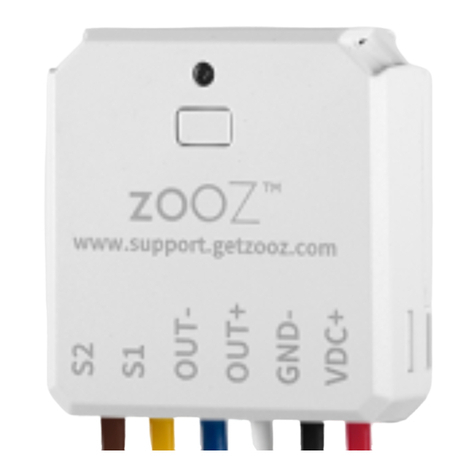
ZooZ
ZooZ ZEN53 LR user manual

Rockwell Automation
Rockwell Automation Allen-Bradley CompactLogix 1769-L32E installation instructions
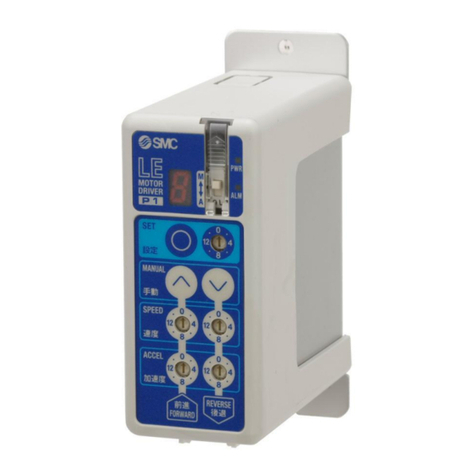
SMC Corporation
SMC Corporation LECP1 series Operation manual
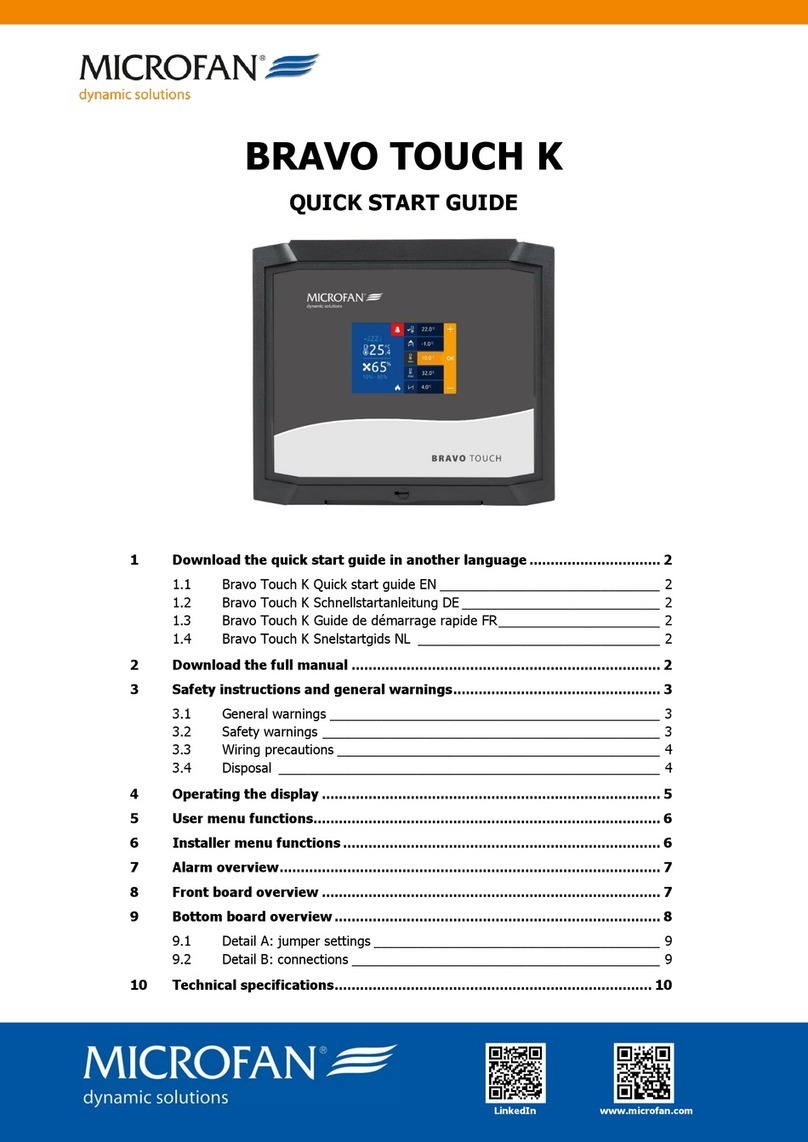
Microfan
Microfan BRAVO TOUCH K quick start guide
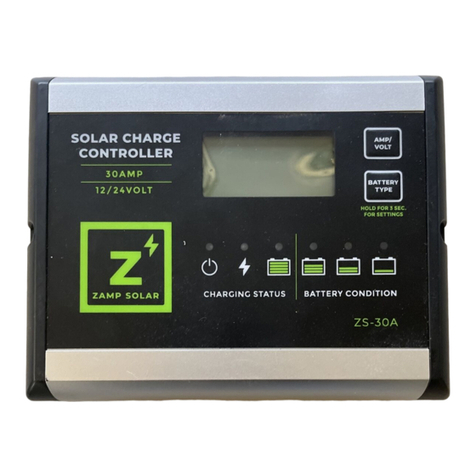
Dometic
Dometic Zamp Solar ZS-30A Deluxe quick start guide
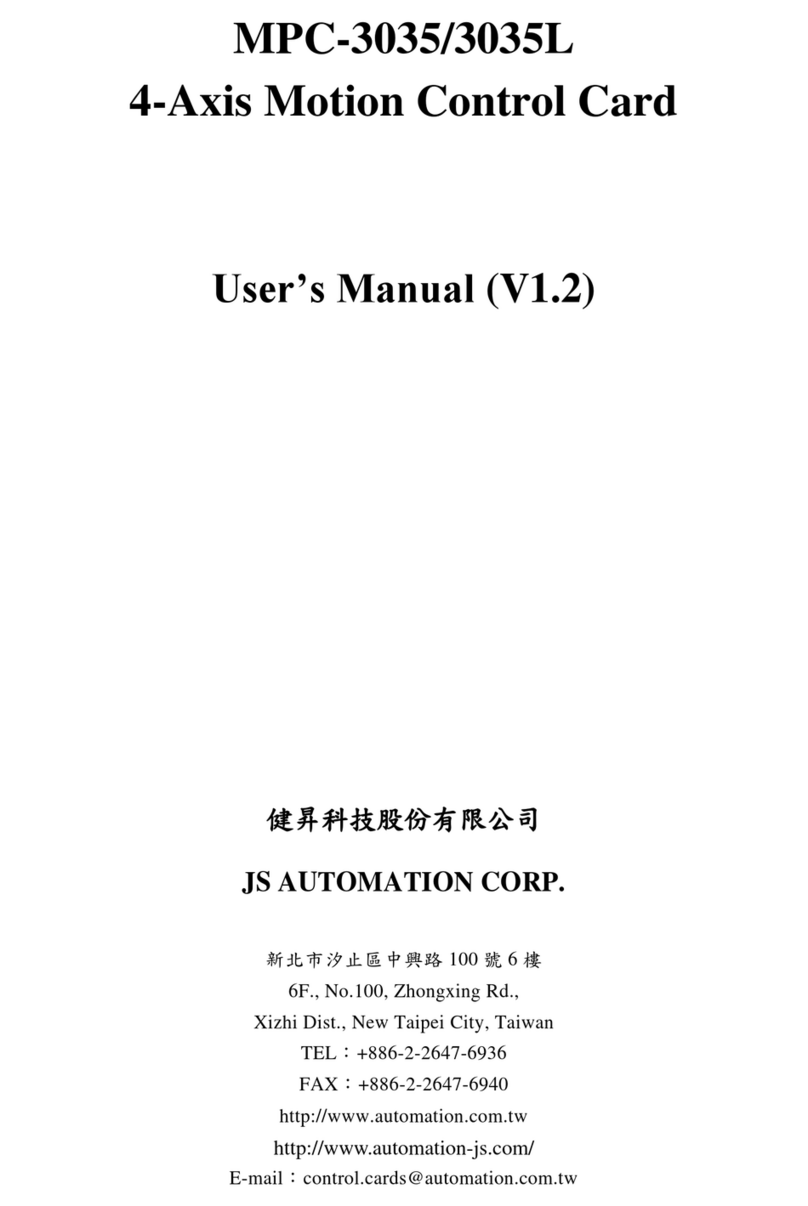
JS Automation Corp
JS Automation Corp MPC-3035 user manual
